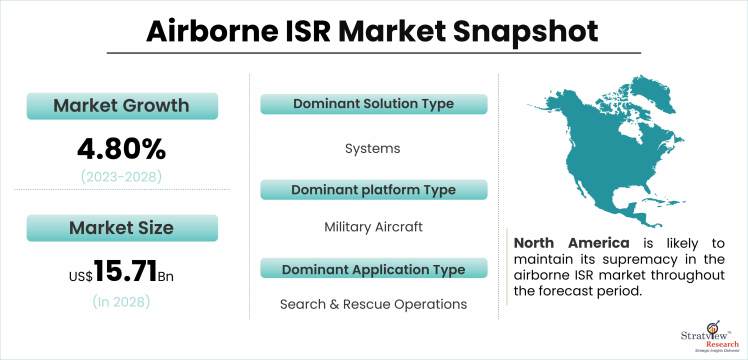In the rapidly evolving landscape of modern warfare, information has become a critical asset, with real-time intelligence providing a significant advantage to military forces. Among the various intelligence-gathering capabilities, Airborne Intelligence, Surveillance, and Reconnaissance (ISR) has emerged as a vital component in enhancing situational awareness and decision-making on the battlefield. This article explores the growing significance of airborne ISR in modern warfare and its transformative impact on military operations. The airborne ISR market is estimated to grow from USD 10.45 billion in 2022 and is likely to grow at a CAGR of 4.9% during 2023-2028 to reach USD 13.96 billion by 2028.
Enhancing Situational Awareness:
Airborne ISR platforms, such as unmanned aerial vehicles (UAVs) and manned aircraft equipped with sophisticated sensors and communication systems, play a pivotal role in gathering valuable information about the operational environment. These platforms provide an aerial perspective that allows military commanders to gain a comprehensive view of the battlefield, detecting and tracking enemy movements, and assessing potential threats.
Target Acquisition and Reconnaissance:
Airborne ISR assets enable real-time target acquisition and reconnaissance capabilities that greatly assist in identifying and tracking high-value targets. Utilizing advanced sensors, such as synthetic aperture radar (SAR), electro-optical/infrared (EO/IR) sensors, and signals intelligence (SIGINT) systems, these platforms can detect, analyze, and collect actionable intelligence on enemy positions, facilities, and activities. Such information helps in planning precision strikes, disrupting enemy operations, and mitigating risks to friendly forces.
Persistent Surveillance:
Airborne ISR platforms offer the advantage of extended endurance and persistence, allowing them to maintain a constant presence over a specific area of interest. This persistent surveillance capability is particularly valuable in monitoring areas that are challenging to access or are located far from friendly bases. By continuously observing the battlefield, airborne ISR assets contribute to early warning systems, enabling timely responses to emerging threats and enhancing force protection.
Force Multiplier:
Airborne ISR acts as a force multiplier by augmenting the capabilities of ground forces. The information gathered by these platforms can be rapidly disseminated to commanders and troops on the ground, enabling them to make informed decisions, adjust tactics, and adapt to changing situations in real-time. This enhanced situational awareness and shared intelligence help in coordinating operations, improving operational effectiveness, and reducing the risks faced by friendly forces.
Reducing Collateral Damage:
Airborne ISR assets play a crucial role in minimizing collateral damage during military operations. By providing accurate and up-to-date information about the location of friendly forces, civilians, and critical infrastructure, these platforms enable commanders to make informed decisions regarding the use of force. This intelligence-driven approach helps to mitigate the risk of unintended casualties and property damage, fostering greater precision and minimizing the impact on non-combatants.
Future Trends and Challenges:
As technology continues to advance, the capabilities of airborne ISR platforms are expected to grow exponentially. The integration of artificial intelligence (AI) and machine learning algorithms into sensor systems will enhance the ability to analyze vast amounts of data, identify patterns, and predict enemy behavior. Additionally, the development of autonomous systems and swarming drones will further expand the reach and effectiveness of airborne ISR.
However, alongside these advancements, challenges persist. Adversaries are developing countermeasures to disrupt or deceive airborne ISR systems, necessitating the constant improvement of sensor technologies and information security measures. Moreover, ethical considerations and the responsible use of intelligence gathered by airborne ISR assets must remain a priority to uphold the principles of international humanitarian law.
Conclusion:
Airborne ISR has become an indispensable tool in modern warfare, offering unparalleled capabilities in situational awareness, target acquisition, reconnaissance, and force protection. With its ability to provide real-time intelligence, persistent surveillance, and enhance operational effectiveness, airborne ISR assets have revolutionized the way military operations are conducted. As technology continues to advance, it is crucial to invest in the development and adaptation of airborne ISR platforms to maintain a competitive edge in the evolving landscape of modern warfare.





Comments